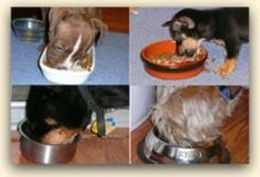Deciphering Dog Food Labels - Part III
AAFCO Statements - Anything Special?
| AAFCO Label Rules Required information for dog food labels. |
|---|
| Product Name |
| List of Ingredients |
| Guaranteed Analysis |
| Nutritional Adequacy Statement |
| Dog Feeding Guidelines |
| Net Quantity Statement |
| Manufacturer's Name and Address |
Sounds impressive enough, no? We dug deeper to find out how much weight these AAFCO statements really carry.
Read on, and then decide for yourself. You can also read more about AAFCO here, and the other organizations who regulate dog food.
Nutritional Adequacy Statements - "Complete and Balanced"
Dog food labels cannot display the term "Complete and Balanced" unless they live up to AAFCO's established guidelines.
In this regard, there are two AAFCO statements which you may see on dog food labels. Dog food companies may choose to display one or the other of the following two statements:-
"(Product Name) is formulated to meet the nutritional levels established by the AAFCO Dog Food nutrient profiles for (specific life stage)." Before a dog food label can display this AAFCO statement, the dog food manufacturers have to ensure the product meets AAFCO’s minimum nutritional adequacy profile. They do this by using the "Calculations Method".
"Animal feeding tests using AAFCO procedures substantiate that (name of product) provides complete and balanced nutrition for (specific life stage)." In this case, the product needs to pass a dog feeding trial.
Let's now take a closer look at these two methods.
Calculations Method

You will find the following AAFCO statement on the dog food label:
Calculations estimate the amount of nutrients either by an average nutrient content of ingredients, or by results of laboratory tests using standard chemical analysis.
Dog Feeding Trials
In this method, the product (or a similar product made by the same company) is tested in dogs, under AAFCO guidelines, to ensure it provides adequate nutritional levels.
If it meets the profile, you will find the following AAFCO statement on the dog food label:
 |
The labels on many commercial dog food brands will proclaim to contain a nutritionally adequate dog food diet, by passing "stringent testing as required by AAFCO."
However! ... Read on ...
- A minimum of only eight dogs are required for the tests.
- The tests run for a six month period.
- During the duration of the test, 25% of the animals can be removed for varying reasons, and
- It is permissible for the remaining dogs to lose up to 15% of their starting body weight.
Now, based on the above, what conclusions can we draw as to the "stringency"(?!!) of this testing, and the value of this AAFCO statement?
Considering only six to eight dogs ate these particular dog food ingredients for six months and survived with no more than an "acceptable" 15% loss of body weight!?
We wonder how many dog owners would consider it "acceptable" for their 30 lb pooch to lose 4.5 lbs in six months?
Life Stage(s) Statement
The section on Nutritional Adequacy also includes a statement about which life stage(s) the dog food is suitable for.
Two profiles are used. Below is a definition of each and additional information about other profiles:
Growth/Lactation - A product intended for growing puppies, for pregnant dogs or lactating females.
Maintenance - Suitable for any adult, non-reproducing dog of normal activity level, but may not be sufficient for a growing, reproducing, or hard working dog.
Terms such as Senior or Formulated for Large Breed Adults, means the dog food ingredients meet the requirements for the maintenance profile, but nothing above that.
A product that doesn't fit within the two profiles above must state, "This product is intended for intermittent or supplemental feeding," unless it is clearly identified as a snack or treat.
Always do your own informed dog food analysis based upon the list of ingredients, and not on any vague AAFCO statements.
Dog Feeding Guidelines
Remember that these dog feeding guidelines are very general. You and your veterinarian are the best people to judge your dog’s requirements, taking into account such factors as breed of dog, age, body weight and activity level.
Net Quantity
Simply put, the net quantity listed on dog food labels indicates how much product, by weight, is in the bag or container.
If you're making a dog food comparison on a cost per ounce or per pound basis, remember to always take into account the difference in moisture percentage.
Manufacturer's Name and Address
This statement identifies the name and address of the party responsible for the quality and safety of the product.
If the label states "manufactured for ..." or "distributed by...," the dog food was actually manufactured for the dog food company by an outside manufacturer.
Although telephone numbers are not a requirement, it's a good sign of a responsible manufacturer who is open to consumer enquiries.
You are here: Home > Dog Food Ingredients and Labels > Dog Food Labels - Part I > Dog Food Labels - Part II > Deciphering Dog Food Labels - Part III
